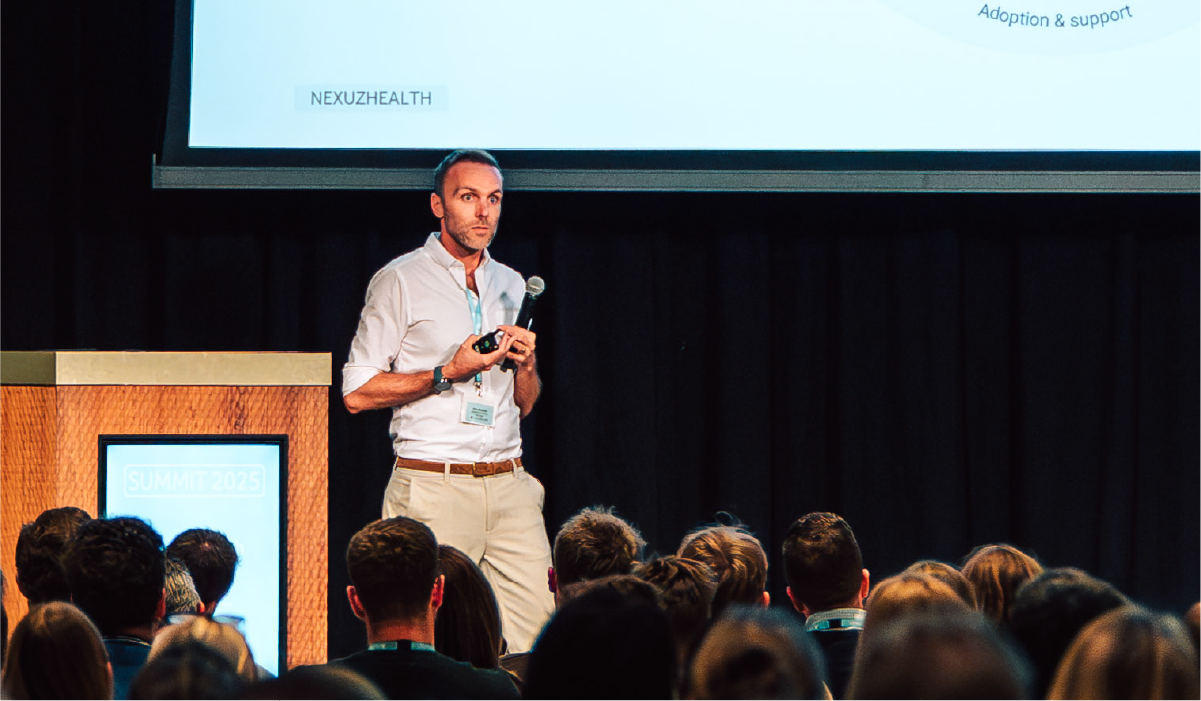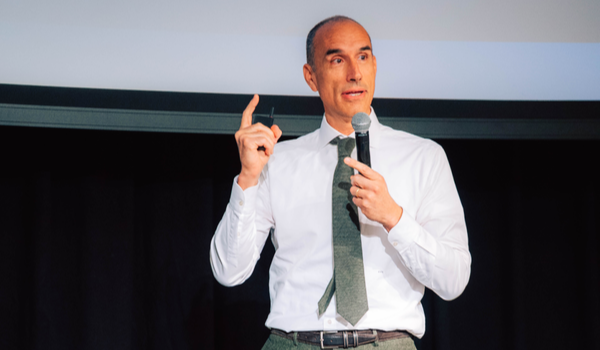Contact the following healthcare facilities directly:
MS Center Melsbroek
AZ Turnhout
Sint-Trudo Sint-Truiden
AZ Glorieux Ronse
AZ Jan Portaels Vilvoorde
Rehabilitation Hospital Inkendaal
Beware of phishing. There are phishing emails circulating that appear to be from nexuzhealth. Click here for more information and tips to protect yourself.

The centralised Electronic Health Record for healthcare institutions brings together all patient data and makes it accessible to the patient and to external healthcare providers involved in their care. This ensures that all medical information is combined into one digital health record: secure, well-structured, and highly efficient. The result: better workflows, deeper medical insights, and optimal collaboration.
In healthcare, patient data is still too often stored across separate systems. As a result, healthcare providers do not always have a complete view of the patient, which can lead to delays or even medical errors. Nexuzhealth developed its centralised Electronic Health Record for healthcare institutions to address this fragmentation. Thanks to this solution, healthcare providers and patients themselves always have access to an accurate, up-to-date, and complete overview of the patient’s medical history, which improves the quality of care.
The Electronic Health Record supports and follows the entire care journey, ensuring that healthcare providers always have access to the right information. Nexuzhealth manages this centralised Electronic Health Record for over 40 affiliated healthcare institutions. This means that each patient has one single record, even when receiving care in several of those institutions.
The centralised Electronic Health Record from Nexuzhealth optimises internal collaboration within your healthcare institution. In addition, it also enables efficient collaboration with other affiliated healthcare institutions and with external healthcare providers, resulting in better continuity of care.
The Electronic Health Record for healthcare institutions is also shared via Nexuzhealth Consult, an app and platform for external healthcare providers. This gives them access to the most up-to-date medical information of a patient. Moreover, this Electronic Health Record is also part of the ecosystem of integrated digital solutions from Nexuzhealth. This enables connection with solutions such as Nexuzhealth Doctor and Nexuzhealth Nurse:
The Electronic Health Record for healthcare institutions is linked to Mynexuzhealth, an app and web platform for patients. Through it, you can not only quickly and securely consult your medical data, but also actively participate in your care journey.
Is certain information not visible in the record? It can be requested from the healthcare provider or institution.
The centralised Electronic Health Record from Nexuzhealth brings all patient data together in one place. Everyone involved in the care process accesses the same record, which is continuously updated as the care journey progresses. It is a dynamic system that not only stores information, but also supports every stage of the healthcare workflow.
From scheduling appointments and tests to treatment follow-up, the Electronic Health Record ensures that each step in the care process runs smoothly. Every healthcare provider sees only the information that is relevant to their role. The result is more efficient collaboration – and therefore better care.
Because all involved healthcare providers work within a single, shared record, there is no risk of ambiguity or conflicting information. Errors caused by outdated or duplicate data are avoided. The Electronic Health Record offers a consistent and clear overview of the patient’s medical history and current condition at all times.
Through Mynexuzhealth, patients play an active part in their care process. They can complete questionnaires, keep diaries, or upload documents. This input is automatically added to their digital health record and helps healthcare providers tailor the care to the patient’s specific needs.
With Nexuzhealth technology, your medical data is always optimally secured. Access to your digital health record depends on the healthcare provider’s role, the therapeutic relationship, and the time of consultation.
Good to know: every time someone views or modifies your digital health record, it is logged. As a patient, you can request to see who accessed your record. This can be done via your hospital’s ombuds service. You will receive an overview of everyone who accessed your record within the past five years, either anonymised or pseudonymised, depending on the hospital.
All healthcare providers and support staff are also bound by medical confidentiality or strict privacy obligations. They may only consult data that is relevant and necessary for your treatment.
As a patient, you can also block specific healthcare providers and/or support staff from accessing your digital health record. You can read more about that here.
Whether you are a patient or a healthcare provider, you can rely on Nexuzhealth. The centralised Electronic Health Record for healthcare institutions is not only highly secure, but also easy to use.
Exercising the rights of another patient can be done in various roles:
A representative can gather information about the health condition and access the patient's medical record.
Are you responsible for making medical decisions on behalf of another patient? In this case, you can become a representative or legal guardian.
Foster parents and proxy holders for healthcare decisions also have certain rights regarding a patient and may access the medical record.
As a parent, you can access the medical record of your child (under 15 years old) through a parent/child link. To prove that you have parental authority, additional documents may be required.
For a child under 15 years (parent/child link)
For a child over 15 years (representative)
Information about your privacy and who has access to your medical record can be found here.
In the 'Access' section, you can find an overview of healthcare providers who have access to your medical record (e.g., general practitioner, healthcare provider, representative, etc.).
Your general practitioner automatically has access to your record. If you do not want this, you can report it to the registration desk at your hospital or revoke access on the website www.mynexuzhealth.be. Other healthcare providers do not have automatic access to your Nexuzhealth record.
If you want to grant access to an external healthcare provider, they must register through www.nexuzhealth.com/en/consult. Once the healthcare provider has access to Nexuzhealth Consult, they need to submit a request to access your record.
If you later wish to deny access to a healthcare provider, you can report it to the registration desk at your hospital or revoke access via www.mynexuzhealth.be.
Accessing the medical record after a patient's death is often a challenging and delicate matter. On one hand, it involves privacy and the protection of personal data, while on the other hand, the patient has passed away and cannot personally object.
The Patient Rights Act provides for only indirect access to the medical record after the patient's death by a healthcare professional (e.g., doctor, nurse, pharmacist, dentist, or paramedic) designated by the requester. This means that the requester cannot personally view the record.
Article 9 of the Law of August 22, 2002, concerning patient rights, stipulates that indirect access to the record of the deceased patient can be requested by the spouse, legal cohabiting partner, partner, and blood relatives up to the second degree (e.g., sisters, grandparents, and grandchildren). Access to the record must be sufficiently motivated and is only possible if the patient did not explicitly object to it during their lifetime.
In the Mynexuzhealth application, access to the patient's record is immediately closed upon the patient's death. The entitled individuals can submit a request for indirect access through the hospital's ombudsman service.
A patient’s file is shared with a healthcare provider when a therapeutic relationship is established between the patient and this healthcare provider. A therapeutic relationship is a relationship between a patient and a healthcare provider in the context of which healthcare is provided, or simply put, the relationship of trust between patient and healthcare provider.
In the absence of a known therapeutic relationship in the system, healthcare providers do not, in principle, have access to the patient’s medical records. However, several other scenarios are possible where access to the file is required. Some examples to illustrate this:
In the above cases, the healthcare provider must apply the ‘break the glass principle ‘. This will also be logged in the system with the corresponding justification of the care provider (e.g. the therapeutic relationship is not yet known by the system).
A patient can choose to deny specific healthcare providers access to their file (so-called “exclusion” of a healthcare provider). As a result, a healthcare provider may, in principle, no longer access the patient file in any way whatsoever. The patient may request an exclusion regardless of whether or not a therapeutic relationship exists or has existed. This allows a patient to apply for a preventive exclusion (e.g. if an ex-partner is a healthcare provider).
In order to ensure continuity of care, a temporary override of an exclusion may be applied. Suppose that an excluded healthcare provider is the only one on duty for a specific medical discipline for which the patient requires urgent care, this healthcare provider will still be able to gain access to the health record.
There are two different types of exclusions:
In order for an exclusion to have the broadest possible effect, it is therefore advisable to register it via the eHealth platform, where non-nexus healthcare institutions can also consult these exclusions.
For more information, click on Exclusion.
Via the Nexuzhealth care institutions, care providers as well as support staff can be excluded. For example, an administrative employee who can no longer consult the patient’s agenda due to an exclusion.Via the eHealth platform, only healthcare providers with a NIHDI number can be excluded for the time being
For more information, click on: Exclusions.
The federal eHealth platform is used as a so-called metahub and connects all regional hubs (such as CoZo or VZN KUL) so that healthcare providers who have a therapeutic relationship with this patient can consult the available documents about the patient (provided the patient has given their global consent). The patient can register exclusions in the eHealth platform that will result in the excluded healthcare providers no longer having access to the health record via the eHealth platform.
Nexuzhealth supplies an Electronic Health Record (EHR) to the Nexuzhealth care institutions. The exclusions of healthcare providers and staff members that the patient has registered via a Nexuzhealth healthcare institution has effect in all Nexuzhealth healthcare institutions.
In addition, the Nexuzhealth applications take over the exclusions registered in the eHealth platform (starting at Q1 2023), so that the healthcare providers who were already excluded for the health record in the eHealth platform are automatically excluded for the health record in the Nexuzhealth healthcare institutions.
Conversely, the eHealth platform does not take over any exclusions from the Nexuzhealth applications.If the patient wants to stop an exclusion, this requires going through the same process as for the application. In concrete terms, this means that an exclusion originally registered via the eHealth platform must be stopped via the eHealth platform. An exclusion requested via a Nexuzhealth healthcare institution can be stopped via the Mynexuzhealth (web) application or via the Nexuzhealth healthcare institution.
For more information, click on: Exclusions
Get inspired by real-world stories, sector news, and meaningful insights. From hands-on experiences to in-depth innovations.



We're here to help
You’ll find answers to the most frequently asked questions on this website. Still have questions? Contact our helpdesk or your hospital.

MS Center Melsbroek – AZ Turnhout – Sint-Trudo Sint-Truiden – AZ Glorieux Ronse – AZ Jan Portaels – Rehabilitation Hospital Inkendaal
MS Center Melsbroek
AZ Turnhout
Sint-Trudo Sint-Truiden
AZ Glorieux Ronse
AZ Jan Portaels Vilvoorde
Rehabilitation Hospital Inkendaal